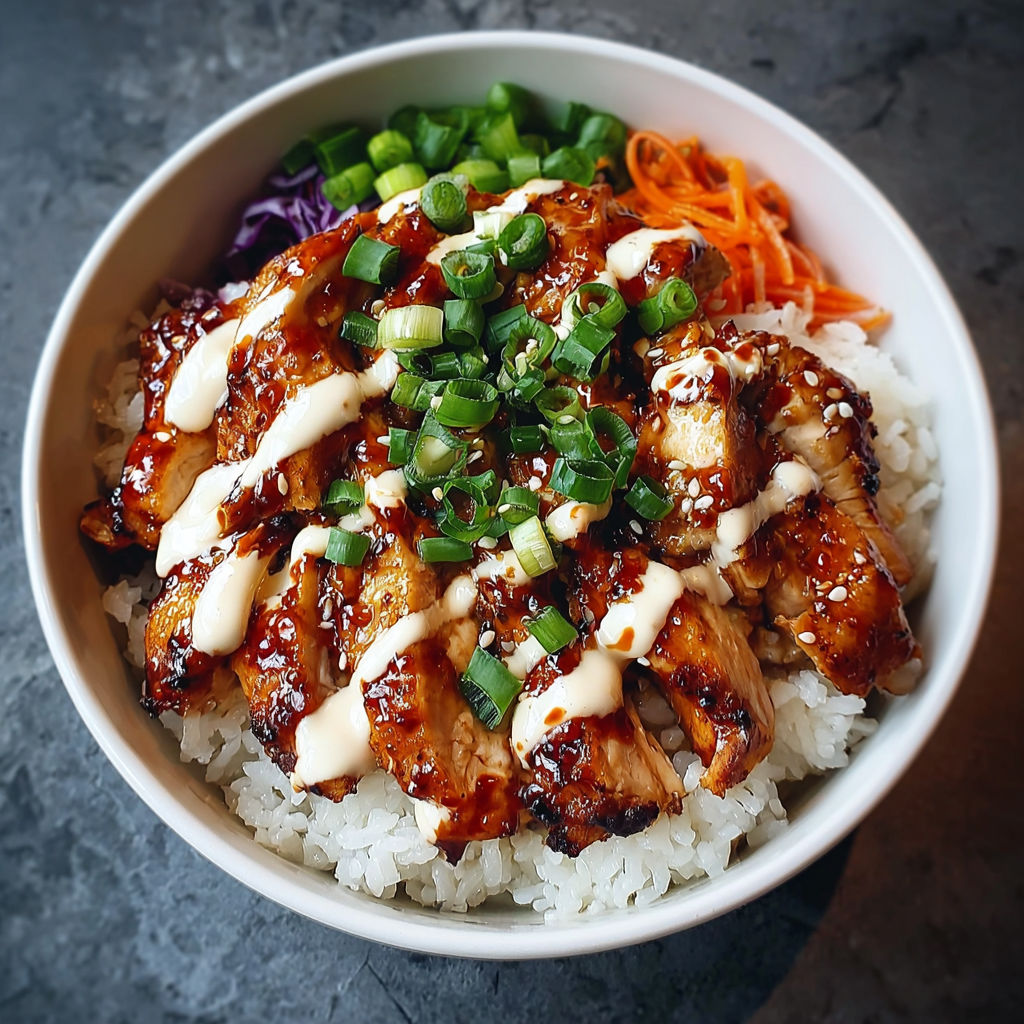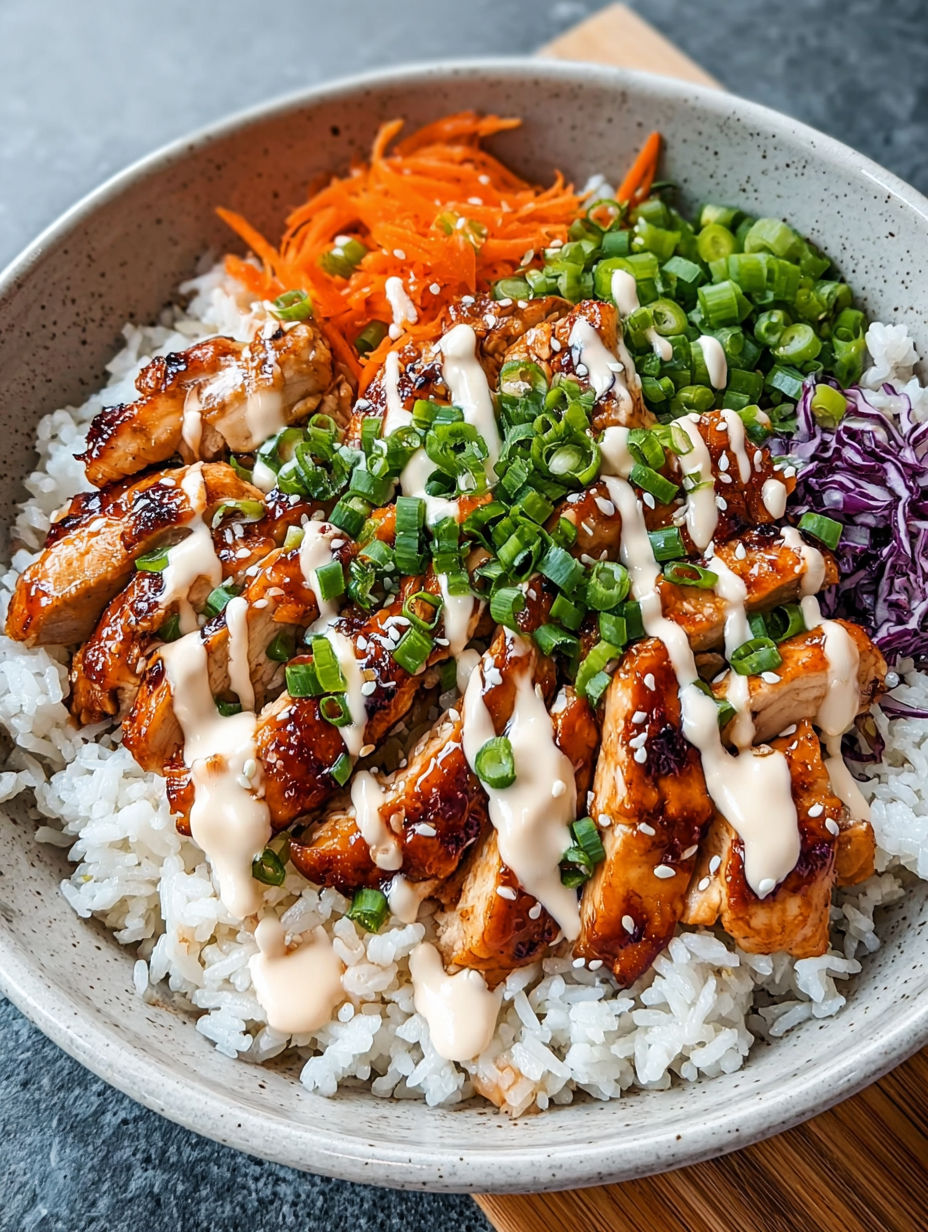 Pin it
Pin it
This homemade Korean chicken bowl brings bold Asian flavors straight to your dinner table without much work. The combo of juicy chicken, bright veggies, and that knockout gochujang cream topping makes a top-notch meal that's surprisingly simple to whip up yourself.
I started making these bowls after eating at a Korean spot with my buddies and falling in love with gochujang. Now I serve them whenever I've got friends over who say they can't handle spicy food—they always wind up wanting my recipe by the end of dinner.
- Chicken breast cut thin across the grain so it stays super tender
- Soy sauce creates the rich umami base in the marinade
- Sesame oil brings that nutty scent that's key in Korean cooking
- Gochujang paste is the main player adding both kick and richness
- Heavy cream cools down the heat from the gochujang in the topping
- Honey provides that touch of sweetness to balance everything out
- Mixed vegetables deliver color vitamins and different textures
- Green onions add a clean sharp finish
- Sesame seeds give a nice little crunch and look pretty too
- Cooked rice go for medium grain if you can for just the right bite
Simple Steps For Korean Chicken Bowls with Spicy Cream Topping
- Marinate the chicken
- Mix your sliced chicken with soy sauce and sesame oil in a container making sure to coat every piece well. Let it sit for at least 30 minutes but more time is better since it softens the meat and pushes flavor deep inside. For the tastiest results you can marinate up to 4 hours in the fridge.
- Prepare the gochujang cream sauce
- Stir the gochujang paste heavy cream and honey together in a small dish until it's totally blended. Start with less hot paste if you're worried about spice—you can always add more later. Your sauce should flow but still be thick enough to stick to a spoon.
- Cook the chicken
- Get a big pan really hot over medium high heat. Put the chicken in just one layer cooking in batches if your pan isn't huge. Let it go about 3-4 minutes each side until it looks golden and isn't pink inside. Move it to a plate and cover loosely with foil to stay warm.
- Stir fry the vegetables
- Using that same pan toss in your mixed veggies and cook for around 3-5 minutes until they're just tender with a bit of snap left. The leftover chicken flavors in the pan will season your vegetables perfectly. If everything looks too dry splash in a little more sesame oil.
- Assemble the bowls
- Put warm rice at the bottom of each bowl. Top with your cooked chicken and veggies. Pour plenty of the gochujang cream sauce over everything. Finish by tossing some cut green onions and sesame seeds on top.
The gochujang paste really makes this dish stand out. I found it a few years back when trying Korean recipes and now always keep some in my fridge. You can't get the same flavor from regular hot sauce so it's worth grabbing at an Asian grocery or online.
Prep Ahead Ideas
These bowls work great for planning meals ahead. You can make all parts separately and keep them in sealed containers in your fridge. The chicken and veggies stay good for 3 days while the sauce lasts up to 5 days. Keep the sauce on its own until you're ready to eat for the best texture. When you warm things up add a tiny bit of water to the rice so it doesn't dry out.
 Pin it
Pin it
Smart Ingredient Swaps
Want to make this without meat? Swap the chicken for firm tofu or tempeh. Squeeze the water out of tofu before adding marinade so it soaks up more flavor. Can't do dairy? Use full-fat coconut milk instead of cream which actually adds a nice extra taste. Running short on time? Grab a rotisserie chicken from the store mix it with some marinade ingredients and just warm it through.
Traditional Korean Elements
To get more genuine Korean vibes add some side dishes called banchan. Most folks know kimchi but you could also try pickled daikon cucumber salad or spinach namul. These extras don't just make the meal more authentic they also bring different textures and tastes to the table. Koreans typically try to include five colors in their meals for better nutrition so think about adding ingredients that help hit this target.
 Pin it
Pin it
Frequently Asked Questions
- → How do I tweak the spiciness of the sauce?
If you want to tone down the heat, start with less gochujang paste, about a teaspoon, and build up slowly. A bit of honey added in will also mellow the spice with sweetness.
- → What veggies work best for this dish?
Great options are broccoli, carrots, and bell peppers, but you can mix it up with fresh zucchini, mushrooms, or spinach. Pick brightly colored ones for contrasting textures and vibrance.
- → Can I prep these bowls in advance?
Sure thing! Cook the components separately and store them in the fridge for up to three days. Reheat the chicken, rice, and veggies when ready, then top with the sauce just before serving.
- → Can I swap the chicken for something else?
Absolutely! Thin beef slices, pork, shrimp, or plant-based alternatives like tempeh or seitan will fit right in. Tofu’s an especially great vegetarian option.
- → What sides go well with this bowl?
Kimchi, cucumber salad, or pickled radish are wonderful Korean-inspired sides. You could also enjoy miso soup or dumplings for a light starter.
- → Where do I find gochujang paste?
Check the Asian section in large grocery stores, visit an Asian supermarket, or browse online. It's often packaged in red containers. In a pinch, mix sriracha with a little miso paste for a similar (but slightly different) kick.
